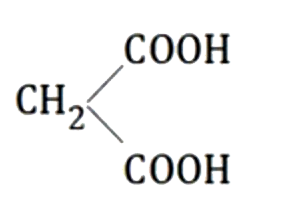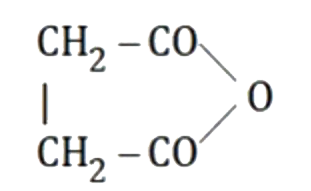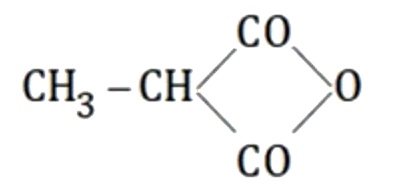In the given reaction CH3−COOH(i) Red −P+Br2−−−−−−−−−−→(ii) NaCN(iii) H2O/H⊕(X)
'X' will be

COOH−CH2−CH2−COOH


The correct Answer is:A
To determine the product 'X' from the given reaction sequence involving acetic acid (CH₃COOH), we will break down the reaction into three steps as described in the video transcript.
Step 1: Reaction with Red Phosphorus and Bromine
1. Starting Material: Acetic acid (CH₃COOH).
2. Reagents: Red phosphorus (P) and bromine (Br₂).
3. Reaction Type: This is known as the Hell-Volhard-Zelinsky (HVZ) reaction, where the acidic hydrogen at the alpha position (the carbon adjacent to the carboxylic acid group) is replaced by bromine.
4. Mechanism: The red phosphorus and bromine will remove the hydrogen atom from the alpha carbon (CH₃-), resulting in the formation of a brominated acetic acid.
5. Product: The product after this step will be 2-bromoacetic acid (CH₂BrCOOH).
Step 2: Reaction with Sodium Cyanide (NaCN)
1. Starting Material: 2-bromoacetic acid (CH₂BrCOOH).
2. Reagent: Sodium cyanide (NaCN).
3. Mechanism: The cyanide ion (CN⁻) acts as a nucleophile and attacks the carbon atom bonded to the bromine (the alpha carbon). The bromine atom leaves, resulting in the formation of a new compound.
4. Product: The product after this step will be 2-cyanoacetic acid (CH₂(CN)COOH).
Step 3: Hydrolysis of the Cyanide Group
1. Starting Material: 2-cyanoacetic acid (CH₂(CN)COOH).
2. Process: Hydrolysis of the cyano group (CN) occurs in the presence of water (H₂O) and typically involves an acid or base to facilitate the reaction.
3. Mechanism: The cyano group is converted into a carboxylic acid group (-COOH) through hydrolysis.
4. Product: The final product after hydrolysis will be 2-hydroxyacetic acid (CH₂COOH), which is also known as lactic acid.
Final Product
The final product 'X' after all three steps is 2-hydroxyacetic acid (CH₂COOH).
Summary of Steps:
1. Step 1: CH₃COOH + P + Br₂ → CH₂BrCOOH (2-bromoacetic acid)
2. Step 2: CH₂BrCOOH + NaCN → CH₂(CN)COOH (2-cyanoacetic acid)
3. Step 3: CH₂(CN)COOH + H₂O → CH₂COOH (2-hydroxyacetic acid)
1. Starting Material: Acetic acid (CH₃COOH).
2. Reagents: Red phosphorus (P) and bromine (Br₂).
3. Reaction Type: This is known as the Hell-Volhard-Zelinsky (HVZ) reaction, where the acidic hydrogen at the alpha position (the carbon adjacent to the carboxylic acid group) is replaced by bromine.
4. Mechanism: The red phosphorus and bromine will remove the hydrogen atom from the alpha carbon (CH₃-), resulting in the formation of a brominated acetic acid.
5. Product: The product after this step will be 2-bromoacetic acid (CH₂BrCOOH).
1. Starting Material: 2-bromoacetic acid (CH₂BrCOOH).
2. Reagent: Sodium cyanide (NaCN).
3. Mechanism: The cyanide ion (CN⁻) acts as a nucleophile and attacks the carbon atom bonded to the bromine (the alpha carbon). The bromine atom leaves, resulting in the formation of a new compound.
4. Product: The product after this step will be 2-cyanoacetic acid (CH₂(CN)COOH).
1. Starting Material: 2-cyanoacetic acid (CH₂(CN)COOH).
2. Process: Hydrolysis of the cyano group (CN) occurs in the presence of water (H₂O) and typically involves an acid or base to facilitate the reaction.
3. Mechanism: The cyano group is converted into a carboxylic acid group (-COOH) through hydrolysis.
4. Product: The final product after hydrolysis will be 2-hydroxyacetic acid (CH₂COOH), which is also known as lactic acid.
The final product 'X' after all three steps is 2-hydroxyacetic acid (CH₂COOH).
1. Step 1: CH₃COOH + P + Br₂ → CH₂BrCOOH (2-bromoacetic acid)
2. Step 2: CH₂BrCOOH + NaCN → CH₂(CN)COOH (2-cyanoacetic acid)
3. Step 3: CH₂(CN)COOH + H₂O → CH₂COOH (2-hydroxyacetic acid)
Topper's Solved these Questions
Similar Questions
Knowledge Check
In the given reaction
CH3−COOH(i). Br2/red P−−−−−−−−−−−−→(ii). NaCN(iii). H2O/H⊕/Δ[X]
[X] will beACH3COOHBCOOH−CH2−CH2−COOHC D
D
In the given reaction
CH3COOH(i)Br2/P−−−−−−−−−−−−→(ii)NaCN(iii)H2O/H⊕/Δ[x],[x] will beACH3−COOHBHOOC−CH2−CH2−COOHC D
D
In the given reaction
C6H5−O∣∣C−CH3(i). Br2/KOH−−−−−−−−−−→(ii). H⊕CHBr3+[X]
[X] will be:AC6H5−CHOBC6H5COOHCC6H5−CH2OHDCH3COOH
In the given reaction
RCN(i)RMgX−−−−−−−−→(ii)H2O/H+(X), (X) will be
View SolutionIn the given reaction
CH3CHO(i). NaCN/HCl−−−−−−−−−−−−−→(ii). H2O/H⊕/Δ(A)Fenton−−−→reagent(B)
(B) will be
View SolutionMeCH2COOH(A)(i)SOCI−−−−−−−→(ii)CH2N2(iii)Ag2O/Pt(B)H2O−−→(C)
Which of the following statements are correct about the given reaction.
View SolutionCH3COOHBr2/P−−−→Y(i)KCN−−−−−→(i)H3O+X Here, X is
View SolutionIn the reaction sequence C6H5−C∣∣O−CH3NH2OH/⊕H−−−−−−−→(A)P2O5−−→[X]
[X] will be
View Solution